 W
WThe Balšić was a noble family that ruled "Zeta and the coastlands", from 1362 to 1421, during and after the fall of the Serbian Empire. Balša, the founder, was a petty nobleman who held only one village during the rule of Emperor Dušan the Mighty, and only after the death of the emperor, his three sons gained power in Lower Zeta after acquiring the lands of gospodin Žarko under unclear circumstances, and they then expanded into Upper Zeta by murdering voivode and čelnik Đuraš Ilijić. Nevertheless, they were acknowledged as oblastni gospodari of Zeta in edicts of Emperor Uroš the Weak. After the death of Uroš (1371), the family feuded with the Mrnjavčevići, who controlled Macedonia. In 1421, Balša III, on his death, passed the rule of Zeta to his uncle, Despot Stefan the Tall.
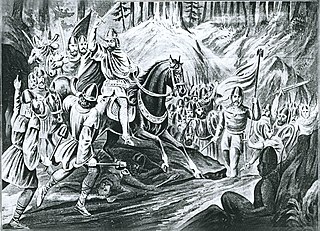 W
WThe Battle of Bar took place on October 7, 1042 between the Serb army of Stefan Vojislav, the ruler of Duklja, and Byzantine forces led by Michaelus Anastasii. The battle was actually a sudden attack on the Byzantine camp in the mountain gorge, which ended in the utter defeat of the Byzantine forces and the deaths of 7 of their commanders (strategoi). Following the defeat and retreat of the Byzantines, Vojislav ensured a future for Duklja without imperial authority, and Duklja would soon emerge as the most significant Serb state.
 W
WBeška Monastery or is a Serbian Orthodox monastery on Beška island on Skadar Lake built in the Principality of Zeta of the Serbian Despotate. It has two churches within its complex, the 'Church of St. George' and the 'St Mary's Church'.
 W
WThe Crnojević was a medieval noble family that held Zeta, or parts of it; a region north of Lake Skadar corresponding to southern Montenegro and northern Albania, from 1326 to 1362, then 1403 until 1515. Its progenitor Đuraš Ilijić, was the head of Upper Zeta in the Medieval Kingdom of Serbia and Empire, under Stefan Dečanski, Dušan the Mighty and Stefan Uroš V. Đuraš was killed in 1362 by the Balšić family, the holders of Lower Zeta ; Zeta was in the hands of the Balšići under nominal Imperial rule until 1421, when Serbian Despot Stefan Lazarević was given the province by Balša III (1403–1421). The family fought its rivals following the murder of Đuraš, and the Crnojevićs controlled Budva from 1392 until 1396, when Radič Crnojević was murdered by the Balšićs. They are mentioned again in 1403, as vassals of the Republic of Venice, taking power in their hereditary lands.
 W
WThe Crnojević printing house or Cetinje printing house, was the first printing house in Southeastern Europe; the facility operated between 1493 and 1496 in Cetinje, Zeta.
 W
WĐurađ Balšić, also known as Đurađ I was the Lord of Zeta between 1362 and 13 January 1378. He was the eldest of the three sons of Balša I, and belonged to the Balšić family.
 W
WThe Monastery of Donji Brčeli, also known as Donje Brčele, or simply Brčeli (Брчели), is a Serbian Orthodox monastery including the Church of St. Nicholas, located near the village of Virpazar in the Crmnica region of Montenegro. It was founded by Jelena Balšić (1365–1443), the daughter of Prince Lazar of Serbia. Šćepan Mali, the impostor pretender of the Russian emperor, was buried here.
 W
WDovolja is a Serbian Orthodox monastery located on the right river banks of the Tara, near Pljevlja, in the village of Premćani within the hamlet of Dovolja. It is dedicated to the Assumption of the Holy Mother of God. It is believed to have been founded by King Stefan Milutin at the end of the 13th century. It was first mentioned in 1513. It is ecclesiastically administrated by the Eparchy of Mileševa. Some time after 1699, the relics of Archbishop Arsenije I were moved from Dovolja to the Dobrilovina Monastery.
 W
WDračevica was a county (župa), a small medieval region located in the mountainous areas to the northwest of Boka Kotorska and the town of Herceg Novi. It corresponds to the Sutorina region.
 W
WDuklja was a medieval South Slavic state which roughly encompassed the territories of present-day southeastern Montenegro, from the Bay of Kotor in the west to the Bojana river in the east, and to the sources of the Zeta and Morača rivers in the north. First mentioned in 10th– and 11th century Byzantine chronicles, it was a vassal of the Byzantine Empire until it became independent in 1040 under Stefan Vojislav who rose up and managed to take over territories of the earlier Serbian Principality, founding the Vojislavljević dynasty. Between 1043 and 1080, under Mihailo Vojislavljević, and his son, Constantine Bodin, Duklja saw its apogee. Mihailo was given the nominal title King of Slavs by the Pope after having left the Byzantine camp and supported an uprising in the Balkans, in which his son Bodin played a central part. Having incorporated the Serbian hinterland and installed vassal rulers there, this maritime principality emerged as the most powerful Serb polity, seen in the titles used by its rulers. However, its rise was short-lived, as Bodin was defeated by the Byzantines and imprisoned; pushed to the background, his relative and vassal Vukan became independent in Raška, which continued the fight against the Byzantines while Duklja was struck with civil wars. Between 1113 and 1149 Duklja was the centre of Serbian–Byzantine conflict, with members of the Vojislavljević as protégés of either fighting each other for power. Duklja was then incorporated as a crown land of the Grand Principality of Serbia ruled by the Vukanović dynasty, subsequently known as Zeta, remaining so until the fall of the Serbian Empire in the 14th century.
 W
WĐurđevi Stupovi is a Serbian Orthodox monastery near the town of Berane, in northeastern Montenegro. It was founded by Stefan Prvoslav, the nephew of Stefan Nemanja, in 1213. Since 2019, it was the cathedral monastery of the Eparchy of Budimlja, until the end of the 17th century. Today, it is the cathedral monastery of the Serbian Orthodox Eparchy of Budimlje-Nikšić in Montenegro.
 W
WThe Macure were an Albanian tribe that lived on the territory on the part of Montenegro which is today known as Šekular. Bratonožići and Rovci. Like other non-Slavic tribes of Montenegro, they were either assimilated or expelled. The majority of scholars consider them to have been of Albanian origin. Today, their name is preserved in local Serbian legends and myths, while their name is sometimes used in Montenegro as derogative.
 W
WMihailo Vojislavljević was the king of Dioclea (Duklja), from 1050 to 1081 initially as a Byzantine vassal holding the title of protospatharios, then after 1077 as nominally serving Pope Gregory VII, addressed as "King of the Slavs". He had alienated himself from the Byzantines when he supported a Byzantine Slavic revolt in 1071–72, after which he then sought to gain support in the West. In 1077 he received a royal insignia by Gregory VII in the aftermath of the Church schism of 1054.
 W
WMorača Monastery is a Serbian Orthodox monastery located in the valley of the Morača River in Kolašin, central Montenegro. It was founded in 1252 by Stefan Vukanović, of the Nemanjić dynasty. It is one of the best known medieval monuments of Montenegro.
 W
WMoračnik Monastery is a Serbian Orthodox monastery on Moračnik island on Skadar Lake in modern-day Montenegro. It is positioned across from the village of Bobovište, whose residents used it as their church before they converted to Islam.
 W
WOrahovo Monastery is a Serbian Orthodox monastery in village Orahovo on Skadar Lake, near Virpazar in the Bar, Montenegro municipality, Montenegro.
 W
WPeter of Diokleia or Petar was an archon of Duklja in the 10th or 11th century. The only information on him is from a seal found in the 19th century, which is decorated on the observe with a bust of the Virgin Mary holding a medallion of Christ and flanked by two cruciform invocative monograms. The text is in Greek letters, saying ΠΕΤΡ[Ο]Υ ΑΡΧΟΝΤΟΣ ΔΙΟΚΛ[Ε]ΙΑ[Σ] ΑΜΗΝ, i.e. "[Seal] of Peter, archon of Duklja, Amen". The seal shows that although Duklja underwent turmoil in the 9th century, the region still continued under Byzantine rule or at least cultural influence.
 W
WPodlastva Monastery or The Monastery of Podlastva is a medieval, women's Serbian Orthodox monastery located in Lastva Grbaljska, in Grbalj, near the coast of Montenegro. The monastery's church is dedicated to the Birth of the Most Holy Theotokos.
 W
WPodmaine Monastery is a Serbian Orthodox monastery built in the 15th century by the Crnojević noble family in Podmaine near Budva, Zeta The monastery has two churches, smaller and older church of Presentation of the Mother of God was built by Crnojević noble family in the 15th century while bigger church was built in 1747.
 W
WPodmalinsko Monastery or Tušinski Monastery is a Serbian Orthodox monastery near Šavnik in modern-day Montenegro.
 W
WPrapratna was a župa (county) in Duklja, and one of the courts of Mihailo I of Duklja, alongside Dekatera (Kotor), according to Byzantine chronicler John Skylitzes.
 W
WPraskvica Monastery is a Serbian Orthodox monastery in Čelobrdo, a village in the Budva municipality in modern-day Montenegro. It was a spiritual and political center of the Paštrovići clan. The name of the monastery is taken from the peach-scented water of the nearby spring.
 W
WPrečista Krajinska is the name for the ruins of a church located in the region of Skadarska Krajina, southern Montenegro. It was the second burial site of Jovan Vladimir, the ruler of Duklja, after his widow Kosara renewed it and transferred his remains from Prespa. The relics drew many devotees to the church, which became a center of pilgrimage. Kosara was interred in the church, at the feet of her husband, on her request. In around 1215—when Krajina was under the rule of Serbian Grand Prince Stefan Nemanjić—the relics were presumably removed from this church and transported to Dyrrhachium by the troops of Michael I, the despot of Epirus. At that time Despot Michael had briefly captured from Serbia the city of Skadar, which is only about 20 km (12 mi) east of the church. The monastery was mentioned in 1417 in a Cetinje manuscript. The Balšić family reconstructed the monastery in the 15th century. The monastery became the seat of a Catholic bishopric, as part of the Catholic-Venetian expansion. The bishop, who was employed in an Orthodox region, saw resistance in the area from the Serbian Orthodox. At the beginning of the 20th century, the population surrounding the Church ruins were Muslims.
 W
WRaška is a geographical and historical region, covering the south-western parts of modern Serbia, and historically also including north-eastern parts of modern Montenegro, and some of the most eastern parts of modern Bosnia and Herzegovina. In the Middle Ages, the region was a center of the Serbian Principality and of the Serbian Kingdom, whose capital was the city of Ras in the late 12th century.
 W
WReževići Monastery or The Monastery of Rezevići is a medieval Serbian Orthodox monastery located in Katun Reževići village between Budva and Petrovac in modern-day Montenegro. The monastery has two churches. According to a local legend, the 'Church of the Dormition of the Mother of God' was built in the 1220s by Stefan Nemanjić, the first king of Serbia while the 'Church of the Archdeacon Stefan' was built by Stephen Uroš IV Dušan of Serbia in 1351.
 W
WSavina Monastery is a Serbian Orthodox monastery of three churches near the city Herceg Novi in the Bay of Kotor, located in thick Mediterranean vegetation in one of the most beautiful parts of the northern Montenegrin coast. It was founded by Stefan Vukčić Kosača, the Duke of Saint Sava.
 W
WThe Kingdom of Serbia, or Serbian Kingdom, was a medieval Serbian state that existed from 1217 to 1346, ruled by the Nemanjić dynasty. The Grand Principality of Serbia was elevated with the regal coronation of Stefan Nemanjić as king by his brother, archbishop Sava, after inheriting all territories unified by their father, grand prince Stefan Nemanja. The kingdom was proclaimed an empire in 1346, but kingship was not abolished as an institution, sice the title of a king was used as an official designation for a co-ruler of the emperor.
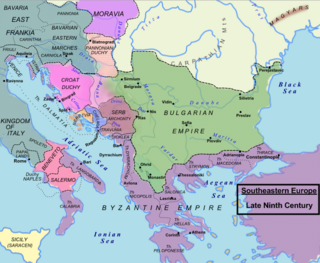 W
WThe Principality of Serbia was one of the early medieval states of the Serbs, located in western regions of Southeastern Europe. It existed from the 8th century up to c. 969-971 and was ruled by the Vlastimirović dynasty. Its first ruler known by name was Višeslav who started ruling around 780. While by that time, starting from the year 681, the Bulgarian state had taken the lands to the east, preparing to conquer Serbia. Vlastimir defeated the Bulgarian army in a three-year-war (839–842), and the two powers lived in peace for some decades. Vlastimir's three sons succeeded in ruling Serbia together, although not for long; Serbia became a key part in the power struggle between the Byzantines and Bulgarians, which also resulted in major dynastic wars for a period of three decades. Central parts of the principality were shortly occupied by the Bulgarian army for three years (924–927), until Serbian prince Časlav was able to liberate the land and unite several Serbian regions, becoming the most powerful ruler of the Vlastimirović dynasty. An important process during this period was the Christianization of the Serbs, the establishment of Christianity as state-religion c. 869, and the founding of the first Serbian eparchy (diocese), the Eparchy of Ras. The principality was annexed by the Byzantines in c. 969-971 and ruled as the Catepanate of Ras. The main information of the history of the principality and Vlastimirović dynasty are recorded in the contemporary historical work De Administrando Imperio.
 W
WThe Serbian Empire is a historiographical term for the empire in the Balkan peninsula that emerged from the medieval Serbian Kingdom. It was established in 1346 by King Stefan Dušan, known as "the Mighty", who significantly expanded the state. Under Dušan's rule Serbia was the major power in the Balkans, and a multi-lingual empire that stretched from the Danube to the Gulf of Corinth, with its capital in Skopje. He also promoted the Serbian Archbishopric to the Serbian Patriarchate. His son and successor, Uroš the Weak, lost most of the territory conquered by Dušan, hence his epithet. The Serbian Empire effectively ended with the death of Uroš V in 1371 and the break-up of the Serbian state. Some successors of Stefan V claimed the title of Emperor in parts of Serbia until 1402, but the territory in Greece was never recovered.
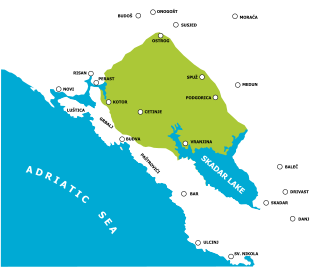 W
WUpper Zeta is a historical region in modern Montenegro, centered around the Zeta Plain, named after the Zeta river. During the Middle Ages, the province of Upper Zeta was part of the Serbian state under the Nemanjić dynasty, existing alongside Lower Zeta. It was then held by the Balšić and Crnojević noble families until the Ottoman conquest (1496). In the early modern period, the term was used for an area in the northern half of the "Old Montenegro" region, though its borders fluctuated.
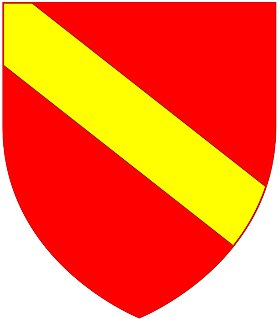 W
WThe Vojislavljević was a Serbian medieval dynasty, named after archon Stefan Vojislav, who wrested the polities of Duklja, Travunia, Zahumlje, inner Serbia and Bosnia from the Byzantines in the mid-11th century. His successors, kings Mihailo I Vojislavljević and Constantine Bodin expanded and consolidated the state. During the 12th century, the main line of the Vojislavljević family was ousted by their cadet branch, the Vukanović, in the late 12th century.
 W
WVranjina Monastery or Vranina Monastery or St. Nicholas' Monastery is a Serbian Orthodox monastery on south-east part of Vranjina island on Skadar Lake in Montenegro. Vranjina Monastery with its church dedicated to Saint Nicholas is one of the oldest monasteries in Montenegro.
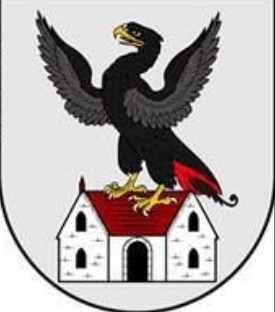 W
WThe Zaharia family was an Albanian noble family that appears for the first time mentioned in the 14th century. A certain Nicholas Zaharia is first mentioned in 1385 as a Balšić family commander and governor of Budva in 1363. After more than twenty years of fidelity, Nicholas Zaharia revolted in 1386 and became ruler of Budva. However, in 1389 Đurađ II Balšić recaptured the city.
 W
WZeta was one of the medieval polities that existed between 1356 and 1421, whose territory encompassed parts of present-day Montenegro and northern Albania, ruled by the Balšić family.
 W
WThe Crnojević noble family ruled the Zeta from 1451 until 1496. The state included parts of modern Montenegro and parts of modern Albania.